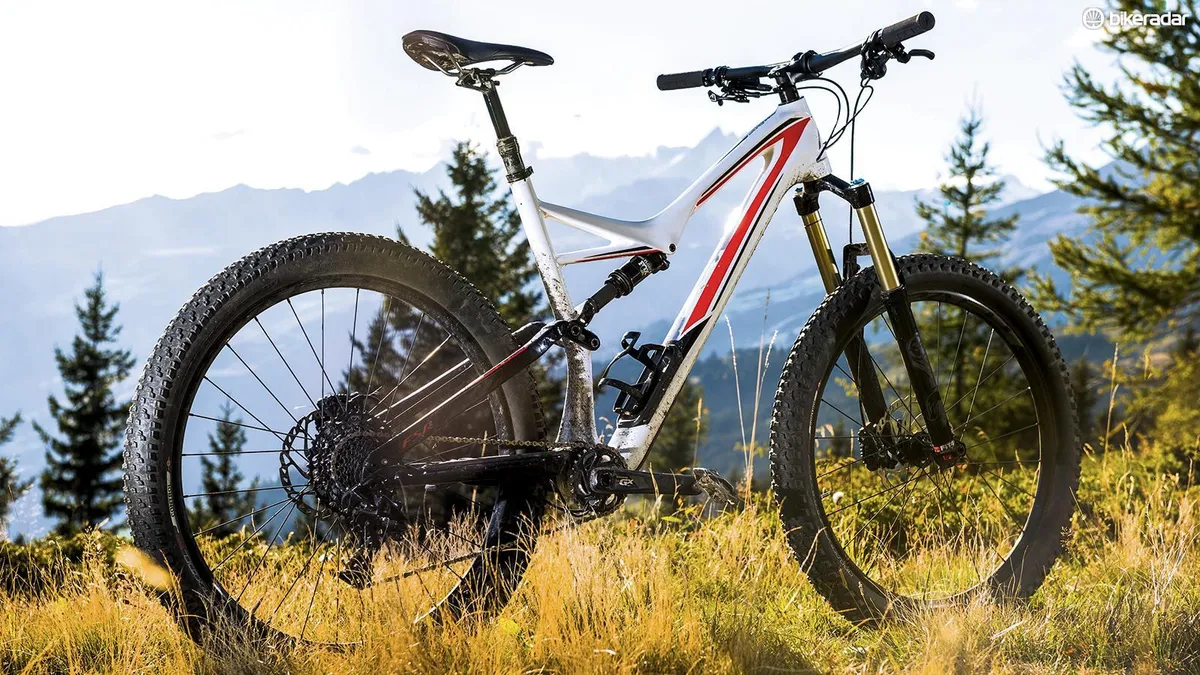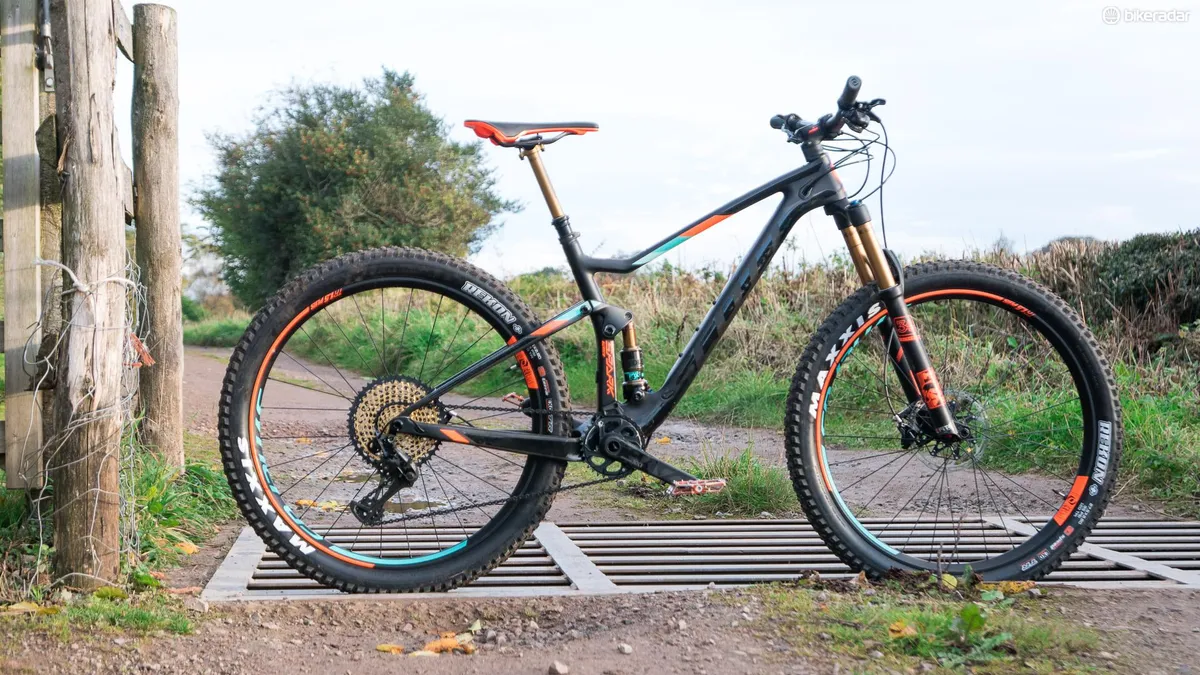If there’s one thing that’s certain in the world of mountain biking it’s change. In particular, there has been a proliferation of standards to do with wheel size and most recently, tyre size.
Plus tyres have been the latest introduction. They use a mid-sized 650b diameter rim that’s around 35-50mm wide with a much higher volume tyre in the 2.8”–3.25” range. The promise is greater grip and comfort and we’ve proven them to be faster in back-to-back tests. It sounds like a done deal for the future of mountain biking — so why are there signs that the days of Plus sized tyres might well be limited?
Plus and minus
The big benefit of the Plus tyre is that it gives you more grip, as Jason Chamberlain from Specialized explains: “Wide tires provide unmatched traction with a negligible loss in rolling resistance. In many situations they climb better because they conform to the terrain more easily and don’t dissipate momentum trying to climb over every little bump and rock. Meanwhile on the descents, some have declared 3.0” tires to be the best suspension upgrade in 20 years.”

Indeed, it was manufacturers trying to offer the soft terrain ‘float’ and grip of a fat bike’s huge rubber footprint in a more wieldy package that led to the category developing. Our testing has also shown a definite speed advantage over 29ers when it comes to roll-down tests as well as timed descents. However, it’s not as open and shut as that.
Even with standard casing tyres, the extra rolling weight can dull handling feel
The downside of a very big tyre is that there’s much more sidewall flex and squirm as well as undamped rebound, as Chamberlain details: “Some riders have discovered mild drawbacks to 3.0". One is that the sidewalls can squirm under hard cornering. Secondly, the sidewalls may not be as durable in some circumstances without adding additional weight. The 2.8" tires seem to be the sweet spot between lightweight, durable casing and sidewall support.”
Even with slightly narrower Plus tyres, pressure is critical in getting a good balance of grip, puncture protection and accuracy, but it’s telling that they haven’t been widely adopted on the enduro racing or downhill scenes despite the increased grip on offer. Even the new Specialized Enduro only comes in 650b and 29er versions, and that's from a brand that's thrown serious weight behind Plus — or 6Fattie, as they call it.
Some of that is down to the fact that a high volume tyre with a casing that’s sufficiently durable to put up with the punishment being dished out would be extremely — and perhaps prohibitively — heavy. The aggressive tread patterns needed to work in wet and muddy conditions, but they come with a much greater weight penalty when transferred over to a Plus format, which explains why there are very few models available and absolutely no mud specific items.

Even with standard casing tyres, the extra rolling weight can dull handling feel. Some of it is down to the fact that the big fat carcass can make the tyres hard to place precisely, something critically important to highly talented racers pushing the limits. It’s an interesting dichotomy that the calmed down handling and terrain smothering are likely to appeal to many riders at the other end of the experience spectrum.
Save for a short lived Plus specific fork from Fox, any bike using a Plus tyre uses a 29er suspension fork, which means longer, heavier and more flexible legs and a knock on effect in terms of the front end height
That said, manufacturers are starting to move away from the bigger Plus tyre sizes to a smaller compromise, as SRAM’s Bastien Donze explains: “Your average Plus tire is now a 2.8”, 3.0” has become the max. And I’m pretty sure you’ll see new rubber in 2.6” popping up. Rim internal width has also gone narrower: 35mm is now what bike brands are asking for. I see a lot of benefits in that trend: lower weight, less undamped feel at the tire, still amazing traction and cornering.
"The great outcome of this whole Plus thing is that tyre makers have been hard at work, and will likely offer amazing products in the short future: bigger tyres that weigh less and with more puncture resistance than in the past. They’re also coming up with super clever carcasses and sidewall compounds that flex less but still offer fantastic trail feel. I for one can’t wait for those to come out.”
One big positive that was heavily sold — that Plus tyres and 29er wheels share the same external diameter and would therefore be interchangeable, giving you two bikes in one — simply isn’t true. A 650b rim with a 2.8” tyre is actually a smaller diameter than a 29er with ‘normal’ volume rubber, meaning you’ll have a noticeable effect on the frame geometry, namely a substantial drop in bottom bracket height. As manufacturers have twigged on to this, they’ve been designing frames specifically around the Plus tyre, rather than simply slotting a new set of wheels into an existing 29er model.
The 29er derived history also brings some issues. Save for a short lived Plus specific fork from Fox, any bike using a Plus tyre uses a 29er suspension fork, which means longer, heavier and more flexible legs and a knock on effect in terms of the front end height. The same goes for the rear of the bike.

On the positive side, the widespread adoption of the wider spaced Boost hub standard has had a positive benefit. Originally made to make 29er wheels stiffer, the wider spacing of the hub and thus wider stance of the fork also means more clearance around fork crown arches when running fatter tyres. It’s since been trickled down to many 650b wheeled forks and frame, which leads to the interesting possibility of running a much fatter than normal tyre in a shorter and stiffer legged fork, with a much easier to package frame rear-end.
Minus Plus?
So, is it likely that Plus tyres as a separate ‘standard’ might be a short lived phenomenon? I’ve spoken to many people in the industry, both on and off the record, and there seems to be a growing consensus that a 650b tyre of around 2.6” wide paired to a 30-35mm rim might be the middle ground between a full Plus tyre and the rubber we’re running today. That would provide many of the benefits of the larger contact without as many of the drawbacks, especially for aggressive riders and riding disciplines. It’d also clear up a lot of confusion about the huge number of different wheel and tyre sizes crowding the market.
If this becomes the new normal for 650b wheels then it means one less thing for consumers to get their heads around when buying a new bike, with confusion over compatibility never being a good thing for bike sales. Another benefit would be that existing owners of 650b wheeled bikes could upgrade to a fatter tyre and rim package without having to buy a new frame or fork.
There has already been a slew of wider rims hitting the market and Maxxis recently introduced a range of ‘Wide Trail’ tyres in 2.4” and 2.5” to suit the more squared off profile these rims give. It’s not such a stretch to think that a slight further increase in volume would be right in the sweet spot between Plus and standard tyres, without all the hassle of needing a new standard. Between this and the resurgence in aggressively angled long travel 29ers, such as the Trek Slash and the Evil Wreckoning, Plus bikes might start to look increasingly irrelevant, at least for trail and enduro racing use.

Donze from SRAM is emphatic on this point: “Looking at all of this, I am very much questioning the need for two different segments of Trail bikes. Do we need to have different categories for 27.5 standard and 27.5 Plus if the tires are only 0.2 inches different and weigh the same? Of course not! We all want bigger tires because they offer better traction, but it used to be hard to justify an additional pound of rotational weight. Now, give me a 2.6” tire that weighs the same as a Minion EXO 2.3 and I’ll never run anything else.
“So, here’s my conclusion and how I see the future. We don’t need that many wheel sizes in MTB today; the industry knows they have to simplify the offer or we’ll lose our customers. I think there is no need for a specific Plus category. I think regular and Plus bikes should merge in order to create a single category where trail and enduro bikes would just have bigger tires, better traction and cornering, but stay as responsive and nimble as they are today.”
Of course, some brands have heavily invested in 27.5 Plus, built marketing campaigns around it and will be reluctant to let it fall by the wayside. There are still many applications where a super tough and precise casing isn’t needed but the extra grip and volume of a proper Plus tyre will be more than welcome, such as hardtails and gentle trail/XC use.
It's also worth pointing out that if you've already bought a Plus machine, then that'll allow you to choose between a fatter 2.8" tyre or a slimmer 2.6" without extreme geometry changes. Whether that’s enough to keep the Plus sized ball rolling is a different matter altogether, something that we’ll see soon enough as the next crop of 2017 bikes are announced.
As ever, let us know your thoughts in the comments below.